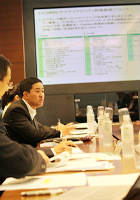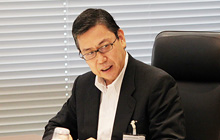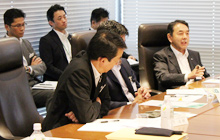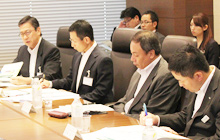Sustainability

1. Directions taken by environmental businesses in which SMBC is engaged Based on trends in ESG measures and information disclosure (comprehensive reports)
Introductory remarks
- Ono:
 The SMBC Environmental Assessment Loan packages, the subject of the discussions of the External Assessment Committee today, were launched five years ago. The Committee meets once a year to discuss various ideas and incorporate them in actual initiatives, such as the overseas rollout of environmental assessment loans, and introduction of the new Environment, Society and Governance (ESG) evaluation system. I hope that our experts here today will give free rein to their views on these matters. So now let us get the discussion started.
The SMBC Environmental Assessment Loan packages, the subject of the discussions of the External Assessment Committee today, were launched five years ago. The Committee meets once a year to discuss various ideas and incorporate them in actual initiatives, such as the overseas rollout of environmental assessment loans, and introduction of the new Environment, Society and Governance (ESG) evaluation system. I hope that our experts here today will give free rein to their views on these matters. So now let us get the discussion started.
Measures undertaken to date
- Moderator:
- First, could you tell us a little bit about the performance of the SMBC Environmental Assessment Loan/Private Placement Bond in fiscal 2012?
- Kato:
- We began handling SMBC Environmental Assessment Loan packages in October 2008. As we built up this product lineup, that was followed by the SMBC ?eco value up" Environmental Assessment Loan product revised for ease of access by SME customers; the Sustainable Building Assessment Loan for promotion of environment-friendly and earthquake-resistant construction; and in April 2013 the SMBC Sustainability Assessment Loan product. With the SMBC Food and Agriculture Assessment Loan featuring evaluation of measures to promote food safety, and SMBC Business Continuity Assessment Loan with evaluation of responses by companies to business succession issues in the event of emergencies such as natural disasters, as well as the interest rate subsidy program introduced by Japan's Ministry of the Environment, we now have seven product packages using the environmental-assessment financing framework and going beyond it. Between October 2008 and March 2013, the number of such loans handled totaled 298, with a total value of ?764.4 billion. The total number of environmental assessment loans was 145, with a total value of ?474.2 billion. Customers who have recently used our range of environmental assessment loans have included an increasing number who want to take out new loans, in order to get objective confirmation of progress in their own companies. In the last fiscal year, there were 15 such repeat transactions out of a total of 81.
New initiatives from fiscal 2013
- Kato:
 The SMBC Sustainability Assessment Loan product was developed on the basis of opinions expressed by previous external committees. While making use of existing environmental-assessment financing frameworks, we chose as evaluation criteria the environment, society and governance, together comprising ESG. Furthermore, a major characteristic of the product is that it takes account not only of environmental initiatives but also of progress in information disclosure.
The SMBC Sustainability Assessment Loan product was developed on the basis of opinions expressed by previous external committees. While making use of existing environmental-assessment financing frameworks, we chose as evaluation criteria the environment, society and governance, together comprising ESG. Furthermore, a major characteristic of the product is that it takes account not only of environmental initiatives but also of progress in information disclosure.
Trends in disclosure of non-financial information
- Moderator:
- In recent years, do you agree that comprehensive reports have gained attention as a new trend in corporate information disclosure?
- Ichimura:
 In the past, corporate reports provided only financial tables and other such information. However, because it became difficult to evaluate enterprise value and make investment judgments based only on such data, companies have begun disclosing information other than financial statistics--so-called non-financial information. For example, in Europe, the Accounts Modernization Directive was issued in 2003, requiring disclosure of non-financial information. All 27 member states have completed incorporation of this Directive into their national legislation. Likewise, in the United States, the New York Stock Exchange in 2009 announced that it would provide investors with ESG and other corporate information, and NASDAQ has also actively began to move towards disclosure of ESG information. These developments have not only concerned the advanced countries, but are also being pursued as national policy in China, Brazil and other countries. In Japan, there has been almost no change over the last five years in the total of over 1,000 companies that compile CSR and environmental reports. However, it has become clear that trends among overseas investors cannot be ignored.
In the past, corporate reports provided only financial tables and other such information. However, because it became difficult to evaluate enterprise value and make investment judgments based only on such data, companies have begun disclosing information other than financial statistics--so-called non-financial information. For example, in Europe, the Accounts Modernization Directive was issued in 2003, requiring disclosure of non-financial information. All 27 member states have completed incorporation of this Directive into their national legislation. Likewise, in the United States, the New York Stock Exchange in 2009 announced that it would provide investors with ESG and other corporate information, and NASDAQ has also actively began to move towards disclosure of ESG information. These developments have not only concerned the advanced countries, but are also being pursued as national policy in China, Brazil and other countries. In Japan, there has been almost no change over the last five years in the total of over 1,000 companies that compile CSR and environmental reports. However, it has become clear that trends among overseas investors cannot be ignored.
Now corporate reporting is again moving into a new stage. At the same time as the importance of ESG is increasing, the development of the Internet and other new media has enabled the publication of a flood of corporate information of various kinds, financial and non-financial. Because it has become difficult for people to find the information they actually need, a need has arisen for comprehensive reports. Comprehensive reports take the important portions of both financial and non-financial information and link these to corporate strategy, aiming to create documents that continuously raise corporate value on a short-, medium- and long-term basis. In this way, the background reason for companies disclosing their long-term orientation is that, since the financial crisis triggered by the 2008 collapse of Lehman's, investors have tended to be focused on the short term.
ESG evaluation spreads into investment and financing
- Arai:
 The disclosure of financial and non-financial information spurs responsible investment. Although the name has changed over time from `socially responsible investment' to `sustainable investment' to `ESG investment,' the responsible investment concept dates back to the 1920s. Even taking account of this long history, I wonder if people realise what a remarkable concept responsible investment actually is. As a constituent part of a society, corporations exist alongside consumers, banks, investors and other entities. Putting it another way, if they are not trusted, corporations simply cannot exist. That is the significance of their constant exposure to public scrutiny. It is precisely the way in which a company is viewed by the public that shapes its responsible investment perspective. Now, with attention focused on non-financial and ESG information, a global consensus that investment should be based on such perspectives is forming. Every country has an organization similar to SIF-Japan, which I am attached to. In January 2013, comprehensive data relating to responsible investing from a range of countries was compiled and published as a report. According to this document, the total amount of responsible investment around the world in 2012 was ?1,356 trillion. Europe accounted for 49% of the assets managed by financial institutions engaged in responsible investment, and the corresponding figures for the United States were 12% and for South Africa 35%. By contrast, the figure was a mere 0.2% for Japan. Furthermore, analysis of the channels for responsible investment shows that 46% of ESG and financial information was classified as ?integrated," that is forming part of the basis for overall investment judgments. I think Japan needs to give serious consideration to what these figures actually mean.
The disclosure of financial and non-financial information spurs responsible investment. Although the name has changed over time from `socially responsible investment' to `sustainable investment' to `ESG investment,' the responsible investment concept dates back to the 1920s. Even taking account of this long history, I wonder if people realise what a remarkable concept responsible investment actually is. As a constituent part of a society, corporations exist alongside consumers, banks, investors and other entities. Putting it another way, if they are not trusted, corporations simply cannot exist. That is the significance of their constant exposure to public scrutiny. It is precisely the way in which a company is viewed by the public that shapes its responsible investment perspective. Now, with attention focused on non-financial and ESG information, a global consensus that investment should be based on such perspectives is forming. Every country has an organization similar to SIF-Japan, which I am attached to. In January 2013, comprehensive data relating to responsible investing from a range of countries was compiled and published as a report. According to this document, the total amount of responsible investment around the world in 2012 was ?1,356 trillion. Europe accounted for 49% of the assets managed by financial institutions engaged in responsible investment, and the corresponding figures for the United States were 12% and for South Africa 35%. By contrast, the figure was a mere 0.2% for Japan. Furthermore, analysis of the channels for responsible investment shows that 46% of ESG and financial information was classified as ?integrated," that is forming part of the basis for overall investment judgments. I think Japan needs to give serious consideration to what these figures actually mean.
- Tomita:
- In May this year, the fourth edition of the Sustainability Reporting Guidelines exploring approaches to disclosure of ESG information was released at an international conference of the Global Reporting Initiative (GRI). At the conference, held in Amsterdam, many attendees from China and Brazil were present, giving an idea of the depth of interest in disclosure of non-financial information. The growth in disclosure of non-financial information around the world is due to a variety of background factors, including international frameworks, and government regulations and securities exchange requirements in individual countries. However, in the total absence of willingness to engage by the authorities in Japan at the moment, I feel that it is up to individual companies to take measures in this regard. Given such apathy, I expect in environmental financing to be a driving force in Japan.
- Adachi:
- Currently, 78 financial institutions have signed the Equator Principles, which set environmental and social acceptability conditions for financing for large-scale projects. Now there is a global push for environmental conditionality to be bundled into financing too. Some countries including China have put in place regulations that prevent banks from providing financing to companies whose activities cause serious environmental pollution. In addition to these curbs, banks are sometimes expected to show environmental awareness with regard to risk management. An easy-to-understand example is soil contamination. This is also a major problem for banks if the value of land placed as collateral is destroyed because the soil is contaminated. Banks have long been developing measures to deal with this problem. Because of this concern on the part of banks, there has been considerable progress in developing measures to deal with soil contamination, and there has also been pressure from the public for banks to show environmental risk awareness.
- Moderator:
- It seems as though initiatives are under way to encourage ESG evaluation at financial institutions, but what about borrower companies?
- Tomita:
 As things stand, in many companies, the CSR departments dealing with ESG and financing departments are not properly integrated. Rather than being aimed at acquiring finance, ESG initiatives have been rolled out with the aim of improving overall business performance and shoring up corporate brand value. Through responsible investment and the Carbon Disclosure Project, I think it will be important to find ways of linking ESG and financing.
As things stand, in many companies, the CSR departments dealing with ESG and financing departments are not properly integrated. Rather than being aimed at acquiring finance, ESG initiatives have been rolled out with the aim of improving overall business performance and shoring up corporate brand value. Through responsible investment and the Carbon Disclosure Project, I think it will be important to find ways of linking ESG and financing.- Arai:
- In both investment and financing, you cannot make proper judgements based only on the past financial information. As long as both investors and investment objects remain hard to identify, I think looking at non-financial information is necessary, to get an idea of the policies and positioning of the company--I mean, what kind of products should it be developing in future, and what kind of overseas strategy should it pursue? And then, how are they going to go about improving enterprise value? These questions are significantly related to non-financial information. You could call non-financial information an indicator of a company's future corporate value.
2. The new SMBC Sustainability Assessment Loan/Private Placement Bond products
What needs to make environmental assessment loan products more attractive?
- Moderator:
- What kind of appraisal criteria and methods are needed for the recently released SMBC Sustainability Assessment Loan to become a useful product for the borrowing company?
- Arai:
- Because the evaluation criteria have gradually changed along with attitudes over time, it is necessary to revise the appraisal criteria in line with new needs. In the debates held by the International Integrated Reporting Council (IIRC), the thing that the GRI guidelines have likewise focused on is “materiality." “Materiality" refers to the factors that can significantly affect future financial and similar aspects of management. It does not take an exhaustive approach, but requires you to ask first, what is important for the company? I think we need clear appraisal of the materiality position for each individual company.
- Ichimura:
- In a comprehensive report, materiality is a significant information perspective for investors and financial institutions who seek to evaluate a company's ability to create long-term corporate value. This is what managements base judgments on.
- Tomita:
- I think that to an extent a comprehensive evaluation is necessary, but I wonder if it is not important to focus on the important elements, rather than to simply provide wall-to-wall disclosure—I mean, look at the inherent characteristics of a given company and then go deeper into those areas. And I think we need not only to ask if ESG measures are adequate, but also how this is contributing to business performance. However much a company is doing for the environment, if it is not helping the business, investors and financial institutions will have reason to ask questions. We are talking here about how ESG and business performance are reconciled, in other words how to evaluate CSV (Creating Shared Value). I would like to see companies doing more to integrate ESG with their businesses.
- Adachi:
 I think talk of materiality and such like is going to cause banks to have to take on a new roles. By which I mean, banks will engage with borrowers from an ESG perspective. In other words, banks are going to have to advise customer companies on materiality. I think there will be some companies that say, we do not need guidance as we have adequately analyzed our operations. I think that a new awareness will arise from such initiatives.
I think talk of materiality and such like is going to cause banks to have to take on a new roles. By which I mean, banks will engage with borrowers from an ESG perspective. In other words, banks are going to have to advise customer companies on materiality. I think there will be some companies that say, we do not need guidance as we have adequately analyzed our operations. I think that a new awareness will arise from such initiatives.- Tomita:
- Some of the companies that have used environmental assessment loan products twice or three times, I think, need not only a comprehensive assessment, but also an in-depth study of their own in-house materiality. If a financial institution gives feedback on behalf of external stakeholders in some way, I think an enterprise has an incentive to continue initiatives and to take things to the next stage. If such positive incentives can be realized, this should generate a high degree of mutual trust or confidence.
What needs to be done to effectively support SMEs?
- Moderator:
- What is necessary for the spread of Environmental Assessment financing?
- Arai:
- Some smaller companies have very good initiatives underway, but it is an issue for them deciding how to go about evaluating them, I think. Environmental management systems for SMEs include the Eco-Action 21 program organized by the Ministry of the Environment and the Eco-stage private sector initiative, but I would like to see these initiatives broadened, using the existing frameworks or alliances with regional banks.
- Tomita:
- Beginning with the Carbon Disclosure Project, I think there are a large number of benchmarks already in place for measuring enterprise value. Furthermore, the terms of these benchmarks are periodically reviewed, and I think companies need to take measures to respond to changes. If there is a corporate social responsibility officer, I think that this can generally be resolved, but there is no question that some indicators seem to be excessively complex as far as management and the financial department are concerned. For many companies to really embrace environmental assessment loan products, it is probably necessary to lower the entry level after adaptation to existing international and other standards.
- Ichimura:
 With regard to SMEs, even when you get a glowing ESG appraisal, I feel that it does not make much difference. How do you go about increasing enterprise value or achieving risk avoidance using the ESG benchmark? I think inviting free composition is one way. If you do that, and you can identify the obstacles to implementation, then I think it should be possible to establish a business strategy.
With regard to SMEs, even when you get a glowing ESG appraisal, I feel that it does not make much difference. How do you go about increasing enterprise value or achieving risk avoidance using the ESG benchmark? I think inviting free composition is one way. If you do that, and you can identify the obstacles to implementation, then I think it should be possible to establish a business strategy.
In Conclusion
Comments from the experts
- Arai:
- Recently, we have seen in Japan major growth in impact investment securities. There are a number of background factors to their popularity, including the fact that they are denominated in foreign currencies, and that the issuer will have an AAA rating. Another important reason is the fact that the investor knows exactly how the money is going to be used. For example, it might be used for people around the world who cannot get access to vaccines, or for providing education in Africa. The investor is aware of how his or her money is actually being used. Assessment-type fund procurement has the advantage that the depositors also know how their money is being deployed, and what kind of companies the bank is supporting. And I think this activity would also be a way of reaching out to ordinary consumers.
- Ichimura:
- Sustainability-related financing is indispensable for the continued stable growth of companies, and dovetails with the policies of the administration of Japanese Prime Minister Shinzo Abe, which is trying to establish long-term market economy mechanisms. With inclusion of the government and all stakeholders, I want to see the Japanese economy moving in a recovery direction. In addition, if the successful elements of this endeavor are rolled out abroad, this will spread the benefits around the world. I think that a further broadening the SMBC assessment-based financing model could take a leading role in that process.
- Tomita:
 Although the number of environmental assessment loan transactions handled by SMBC is growing steadily, it still has not reached the stage where it can exert substantial influence in terms of overall financing. I want to see the Bank targeting a level above 49%, the proportion of environmental assessment loans prevailing in Europe. I think it is also necessary to be careful that everything is not done shoddily, but I want to see a greater proportion of loans made with specific numerical targets. Mr. Arai proposed reaching out to the ordinary consumer, and I think it would be successful if we can raise the proportion of environmental assessment loans to 50%. If such thinking spreads, I think you can become a green bank and live up to your logo colors.
Although the number of environmental assessment loan transactions handled by SMBC is growing steadily, it still has not reached the stage where it can exert substantial influence in terms of overall financing. I want to see the Bank targeting a level above 49%, the proportion of environmental assessment loans prevailing in Europe. I think it is also necessary to be careful that everything is not done shoddily, but I want to see a greater proportion of loans made with specific numerical targets. Mr. Arai proposed reaching out to the ordinary consumer, and I think it would be successful if we can raise the proportion of environmental assessment loans to 50%. If such thinking spreads, I think you can become a green bank and live up to your logo colors.
Comments in response to the External Assessment Committee's discussion
- Nakamura:
 While optimizing our functions as a financial institution, we should realize social responsibility through our core businesses. That is what CSR should be all about, I think. In that light, the bank has put a lot of effort into its environmental assessment loans. At the External Assessment Committee today, I got a very strong reaffirmation that non-financial initiatives are closely linked to our customers' main businesses, and that we are now in a time where there is pressure for appropriate disclosure of this to stakeholders. Likewise, regarding materiality, we are also at a point where we need to thoroughly consider in what terms we view materiality--for which stakeholders and in relation to what.
While optimizing our functions as a financial institution, we should realize social responsibility through our core businesses. That is what CSR should be all about, I think. In that light, the bank has put a lot of effort into its environmental assessment loans. At the External Assessment Committee today, I got a very strong reaffirmation that non-financial initiatives are closely linked to our customers' main businesses, and that we are now in a time where there is pressure for appropriate disclosure of this to stakeholders. Likewise, regarding materiality, we are also at a point where we need to thoroughly consider in what terms we view materiality--for which stakeholders and in relation to what.
Based on the valuable opinions we have heard today, I think we can set about reviewing existing products and developing new products. Public attitudes will have to change too, so as to ensure that progressive measures or information disclosures are appropriately reflected in enterprise value. Our bank is fully committed to playing a part in helping to realize this. We have discussed these matters for a long time today. Thank you all for your contributions.